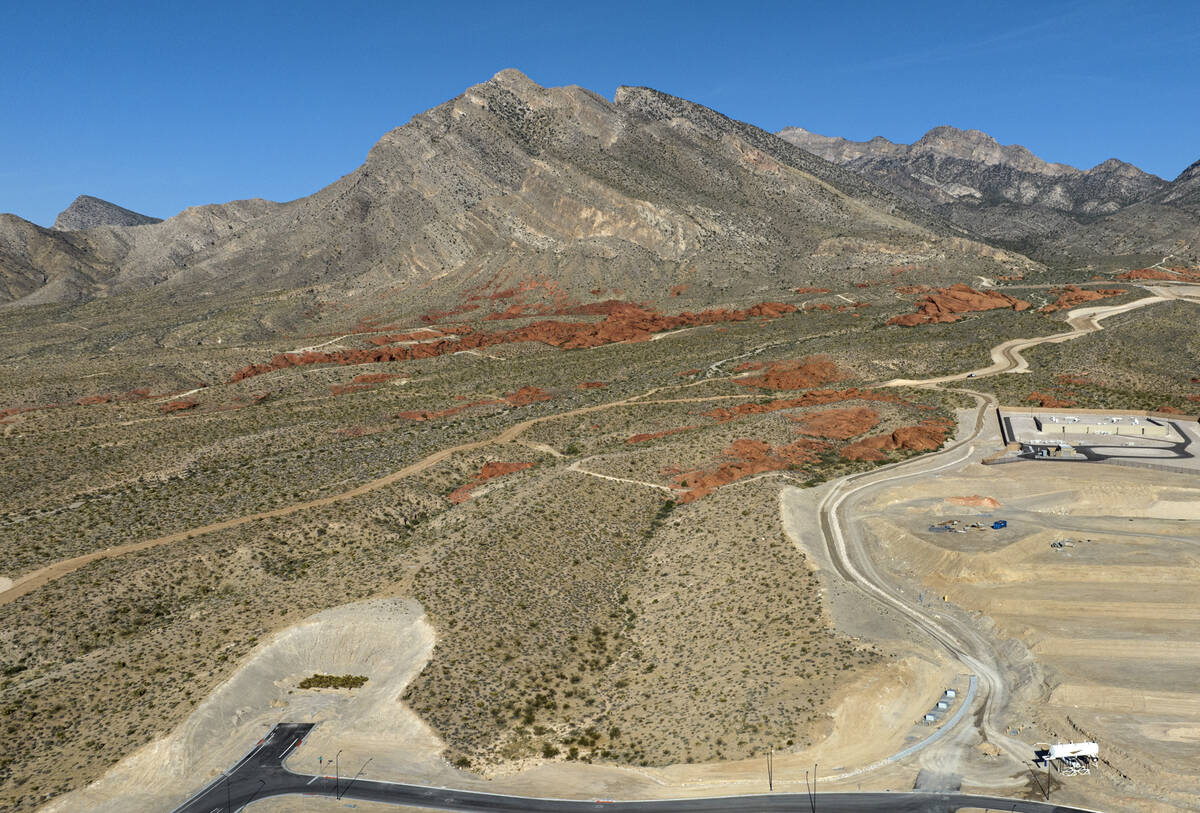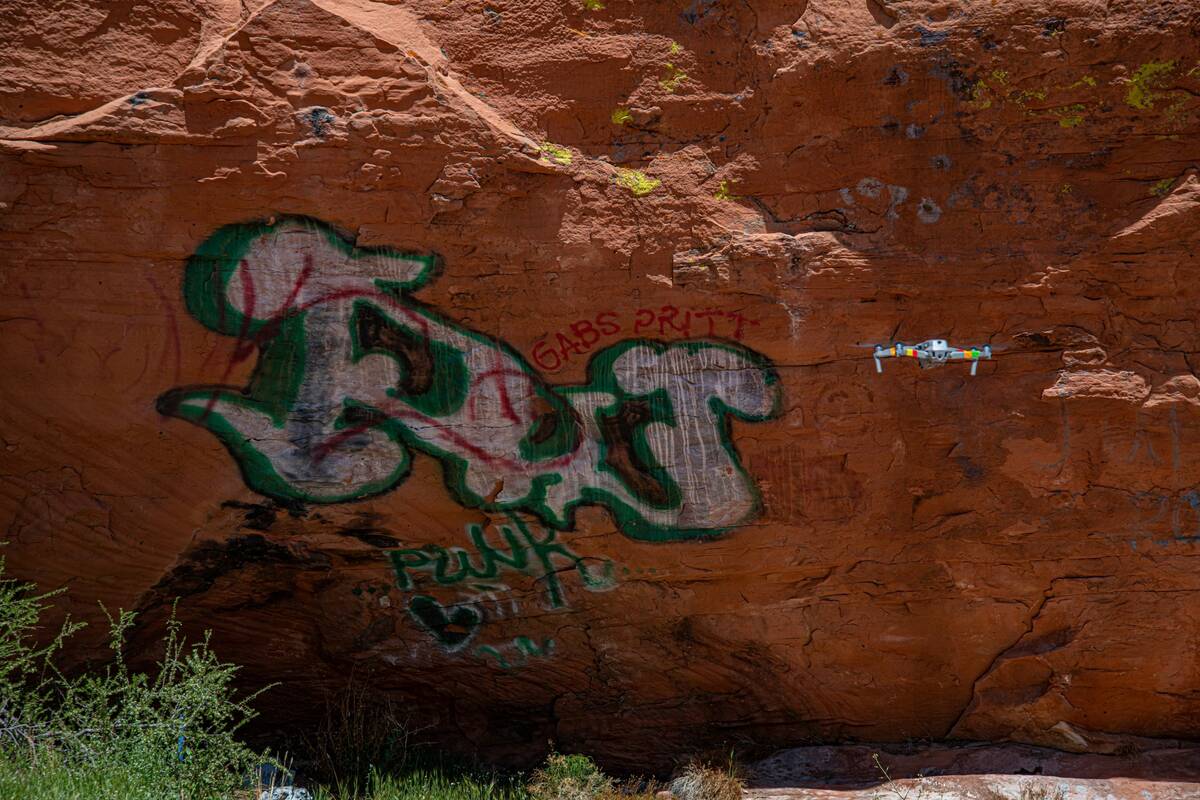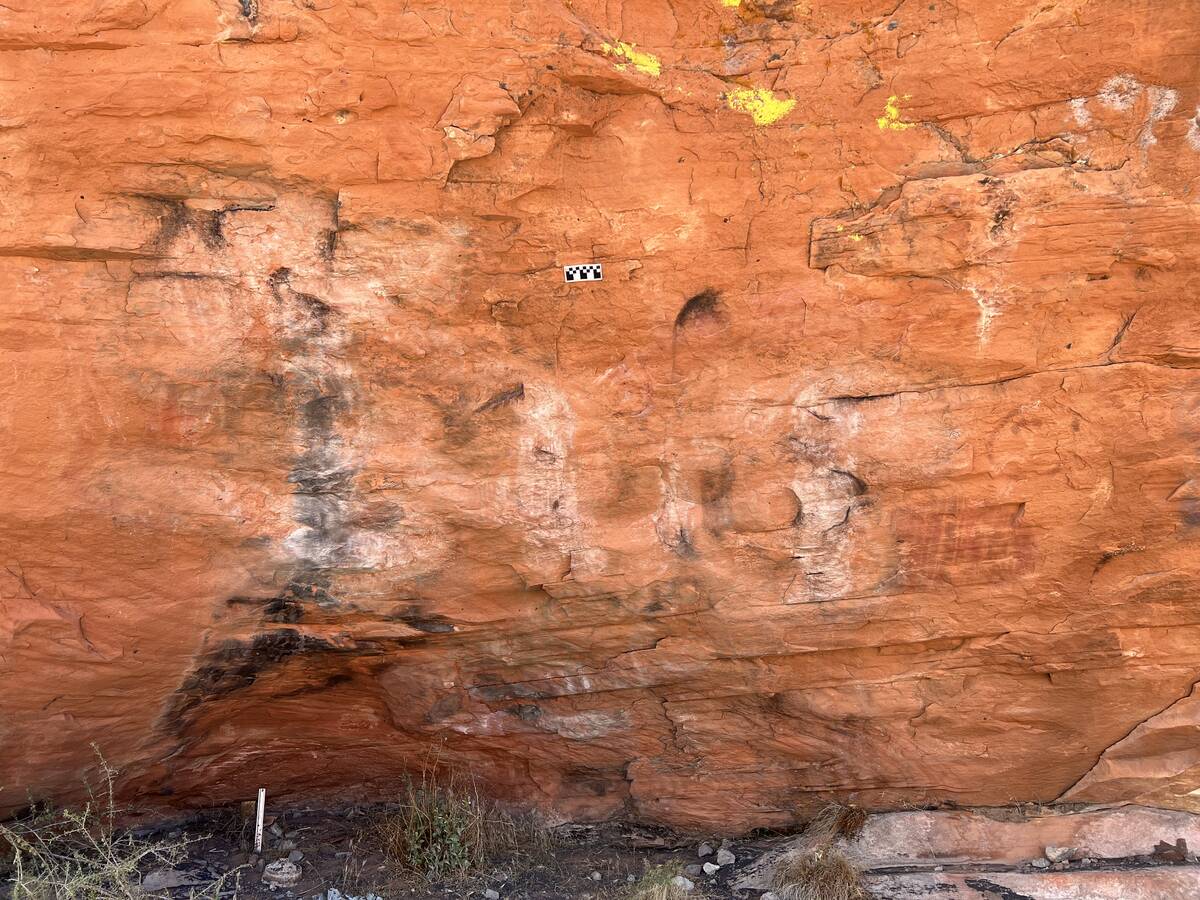Little Red Rock, home to ancient petroglyphs, now has luxury housing project nearby
Some 30 years ago, Little Red Rock was getting trashed.
The outcropping of red rocks, located on private property on Las Vegas’ outer edge near Red Rock Canyon, had become a destination for graffiti, drinking and shooting guns. The spread is home to ancient petroglyphs and other cultural history, but vandalism persisted for years.
Now, as suburban sprawl keeps expanding Las Vegas’ waistline, construction crews are working just outside the site on a new housing project for the wealthy.
Summerlin developer Howard Hughes Holdings is carving a luxury community into the desert a few miles northwest of the Summerlin Parkway-215 Beltway interchange. The Texas-based company sold six homesites for nearly $23 million combined in December in the custom-home enclave, known as Astra.
Buyers have to build their homes and will get elevated, panoramic views of the Las Vegas Valley. They also will enjoy close-up views of the mountains around them and the neighboring Little Red Rock area, which contains petroglyphs and pictographs that are said to be thousands of years old.
Hughes CEO David O’Reilly told analysts earlier this year that Astra is a 170-acre mountainside community, and the sales values show Summerlin’s appeal to “ultra-luxury homebuyers.”
Summerlin’s developer has long owned the Little Red Rock property and works with various groups to preserve the site, which is located in Las Vegas city limits. The notion of a potential real estate project nearby was contemplated decades ago, though for now it’s unclear how, or if, the new housing tract would affect the site.
Numerous people would live nearby, but the project also brings more control to what had been wide-open desert surroundings.
‘Historically important area’
Little Red Rock had long been used as a party spot, and graffiti accumulated over time, said Nevadans for Cultural Preservation Executive Director Rayette Martin, who has worked with the landowner in recent years to lead cleanup efforts there.
She cautioned that curiosity-seekers who want to venture to Little Red Rock would not only trespass on private property but can damage the area by unknowingly walking on agave roasting pits or sitting on petroglyphs.
Martin noted that ancient peoples stayed there to gather resources, hold ceremonies and the like and that the area still holds significance to Southern Paiutes and others.
After the Las Vegas Review-Journal asked to speak with Hughes Holdings about its plans for Little Red Rock, including whether it would block or somehow restrict access to the site, it released a statement saying the company is focused on Little Red Rock’s preservation.
Matt Walker, director of community and government relations at Hughes Holdings for Summerlin, said the developer continues to work closely with Martin’s group, archaeologists, government agencies and the Las Vegas Paiute Tribe “to protect and preserve this historically important area.”
He also said that Summerlin has a “history of stewardship” that includes two major land exchanges with the federal Bureau of Land Management that enlarged the neighboring Red Rock Canyon National Conservation Area.
In 1988, a land swap with the BLM that was facilitated by The Nature Conservancy involved Summerlin’s developer giving up 5,000 acres of environmentally sensitive land in exchange for 3,000 acres of land that was “more appropriate for development,” the company says.
In 2002, the developer traded 1,000 acres in Summerlin’s western region to the BLM for about 1,000 acres along the community’s southern edge.
‘Beer-swilling yahoo’
Summerlin, which spans 22,500 acres along the Las Vegas Valley’s western rim, today boasts 130,000 residents and some of the highest home prices in Southern Nevada.
Its developer’s namesake, Howard Hughes, the famed aviator, business tycoon and recluse, acquired the land mass in the 1950s. He died in 1976, and the Summerlin master-planned community started taking shape in the early 1990s.
In 1995, the Review-Journal reported that the word was out about Little Red Rock Canyon, as the paper called it, evidenced by the burned-out hulk of an old Chevy, hollow shotgun shells, empty beer cans and spray-painted graffiti.
Summerlin officials sent security patrols to periodically keep an eye on the rock formations, the newspaper reported.
“You don’t want the average beer-swilling yahoo going out there to deface them,” Summerlin’s then-chief planner Jeff Rhoads said at the time.
Hughes officials also said they would consider trading the petroglyph-covered rocks with the BLM for prime real estate elsewhere, the newspaper reported.
‘Something must be done’
In 1997, the Review-Journal reported that vandals had defaced sandstone walls in Little Red Rock Canyon. Scraps of wood and chopped palm-tree trunks had been hauled there to use for campfires, an empty Budweiser box was left behind, and petroglyphs were pocked with bullet holes.
Rhoads and a BLM archaeologist both felt that a controlled-access, low-density development that incorporated the outcroppings into a park or golf course would afford more protection to the ancient art rock, the Review-Journal reported.
Later that year, William White, then-senior archaeologist at UNLV’s Harry Reid Center for Environmental Studies, wrote in a letter to the editor in the Review-Journal that Little Red Rock was “threatened by potential development.”
“Indeed, what is needed is a joint effort not to create another park, but to control growth in the valley,” he wrote.
He acknowledged this was unlikely, given Las Vegas’ booming population, but he added that “something must be done, immediately.”
In early 2001, the Review-Journal reported that then-state Senate Minority Leader Dina Titus — now a member of Congress — was concerned by development on scenic hillsides and near the Little Red Rock area.
She introduced a bill in March 2001 that would have forced local governments to identify environmentally sensitive areas and protect them with buffer zones. At a committee hearing the next month, however, she said she had received the bill draft just before the deadline to introduce legislation and that she would have corrected some parts of it, according to meeting minutes.
Titus said that after meeting with local governments, developers and environmental groups, there was consensus that the bill could not be fixed in the short time left in that year’s legislative session, the minutes show.
The measure went nowhere.
Scrubbing rocks
Martin, of the preservation group, first visited Little Red Rock in 2022, and the main eyesore was graffiti, she recalled.
She runs littleredrock.org, which states that some petroglyphs, or pecked images, and pictographs, or painted images, in the Little Red Rock area are thousands of years old. They were made by ancestors to today’s Native Americans, and many of the images are difficult to see, given the exposure to the elements, according to the site.
“For decades, visitors have defaced and damaged Little Red Rock,” says the website, which notes that entering the area without permission from the landowner is trespassing and that archaeological resources are protected by law as well.
It also says law enforcement and archaeologists monitor the site, and graffiti remediation efforts have “brought the area back to nature.”
Martin said it’s much easier working with a private landowner like Hughes Holdings than an entity like the BLM. The developer has a relatively smaller area to manage with Little Red Rock and can deal with issues faster, she explained.
But she noted that people will go there anyway, whether they’re allowed to or not, and can harm the area.
In 2023, Martin trained 33 volunteers who scrubbed rocks for nearly 930 hours combined, she said. Despite their efforts, these kinds of areas will never be the same.
“There’s always an impact,” she said.
Contact Eli Segall at esegall@reviewjournal.com or 702-383-0342.
Freeway art
The ancient petroglyphs in Little Red Rock are on private property in the desert, but the landowner found a way to share the images with Las Vegas Valley residents.
Summerlin developer Howard Hughes Holdings, as the company is now known, funded art work on overpasses at the 215 Beltway that show petroglyph-like images similar to those in the Little Red Rock area, according to reports in the Las Vegas Review-Journal in 2000.
The developer met with representatives of the Las Vegas Paiute Tribe to ensure the images would be reminiscent and respectful of the original rock art, a report said.
All told, the project would not only give Beltway overpasses in Summerlin a distinctive look, but also allow the company “to share with the community the historically significant Native American images from our region,” a Hughes executive said at the time.
The images can be seen today from the freeway, including on the Charleston Boulevard and Sahara Avenue overpasses.
— Eli Segall





























